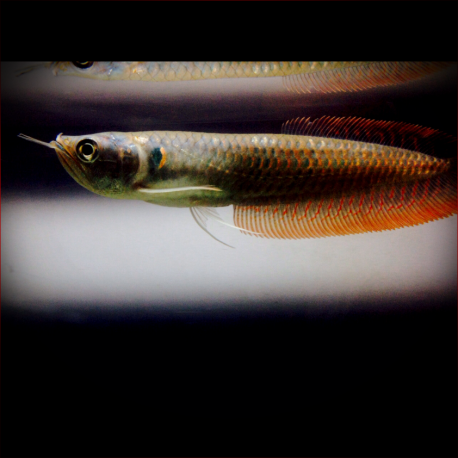More info
Datasheet
| Minimum Tank Size | 10000 litres / 2641.72 US gallons |
| Maximum Size | 80.0cm / 31.50inches |
| Temperature | 20°C / 68.00°F - 30°C / 86.00°F |
| Hardness | 2.02dgH / 36ppm - 15.02dgH / 268ppm |
| pH | 5.0-7.5 |
General Description
The Silver Arowana, scientifically classified as Osteoglossum Bicirrhosum, belongs to the Osteoglossiformes order. This freshwater species is known for its large size, with adults reaching up to 80.0cm in length. It is a generalist predator, feeding on other fish, terrestrial insects, aquatic invertebrates, and plant material like fallen nuts and fruits. The family Osteoglossidae, to which it belongs, dates back to around 150 million years to the Jurassic Period.
Aquarium Setup
The Silver Arowana requires a tank size of a minimum 10000 liters. The setup should include surface cover such as floating plants or overhanging vegetation. It thrives in stable water conditions with a pH range of 5.0-7.5, hardness between 36-268ppm, and a temperature of 20-30°C. High dissolved oxygen levels and moderate water movement are essential, achieved through external filters, powerheads, and airstones. Additionally, a secure, heavy lid is necessary due to their jumping behavior.
Behaviour
In an aquarium setting, the Silver Arowana is peaceful with tankmates too large to be considered prey. Careful selection of community fish is vital, avoiding aggressive or very competitive species. In smaller tanks, they may exhibit aggression towards conspecifics due to limited space, establishing a pecking order even in larger setups. Other surface-dwelling fish should be avoided unless in very large tanks.
Feeding and Diet
As a predator, the Silver Arowana's diet consists of various food sources. Juveniles can be fed bloodworms, earthworms, prawns, and insects, while adults accept fish flesh, prawns, mussels, and earthworms. It is essential to avoid feeding them mammalian or avian meat like beef heart or chicken. This species does not benefit from feeder fish and should be provided with a varied diet for optimal health.
Reproduction & Dimorphism
Although not commonly recorded in home aquariums, the Silver Arowana is commercially bred in outdoor facilities. It is a paternal mouthbrooder, with males carrying the eggs and fry for approximately two months. Females can produce 50-250 eggs per reproductive season, with typical brood sizes ranging from 12-30. The fry hatch at a size of 50-75mm and are available in the trade at a young age.
Habitat and Distribution
In the wild, the Silver Arowana is found in slow-moving to still tributaries, backwaters, and lagoons, particularly in the Amazon basin in countries like Brazil, Peru, Colombia, and Ecuador. It also inhabits the Rupununi and Oyapock systems in Guyana and French Guiana. The species tends to be a surface dweller, preying on smaller fish and terrestrial insects, known for its exceptional leaping ability to catch prey.

